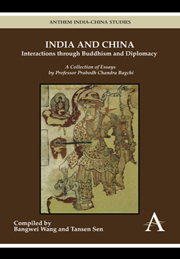 India and China: Interactions through Buddhism and Diplomacy
India and China: Interactions through Buddhism and Diplomacy Book contents
- Frontmatter
- Contents
- Compilers' Note
- Introduction (English and Chinese)
- Part One
- 1 Ancient Chinese Names of India
- 2 The Beginnings of Buddhism in China
- 3 Indian Influence on Chinese Thought
- 4 A Note on the Avadānaśataka and its Chinese Translation
- 5 Bodhisattva-śīla of Śubhākarasiṁha
- 6 A Fragment of the Kāśyapa Saṁhitā in Chinese
- 7 The Chinese Mysticism
- 8 Some Early Buddhist Missionaries of Persia in China
- 9 Some Letters of Hiuan-Tsang and his Indian Friends
- 10 New Lights on the Chinese Inscriptions of Bodhgayā
- 11 A Buddhist Monk of Nālandā amongst the Western Turks
- 12 Political Relations between Bengal and China in the Pathan Period
- 13 Chinese Coins from Tanjore
- 14 Report on a New Hoard of Chinese Coins
- 15 Ki-pin and Kashmir
- 16 Sino-Indian Relations – The Period of the United Empires (618–1100 A.D.)
- Part Two Short Articles
- Part Three Articles in Bengali
- Appendix
- Index
11 - A Buddhist Monk of Nālandā amongst the Western Turks
from Part One
Published online by Cambridge University Press: 05 March 2012
- Frontmatter
- Contents
- Compilers' Note
- Introduction (English and Chinese)
- Part One
- 1 Ancient Chinese Names of India
- 2 The Beginnings of Buddhism in China
- 3 Indian Influence on Chinese Thought
- 4 A Note on the Avadānaśataka and its Chinese Translation
- 5 Bodhisattva-śīla of Śubhākarasiṁha
- 6 A Fragment of the Kāśyapa Saṁhitā in Chinese
- 7 The Chinese Mysticism
- 8 Some Early Buddhist Missionaries of Persia in China
- 9 Some Letters of Hiuan-Tsang and his Indian Friends
- 10 New Lights on the Chinese Inscriptions of Bodhgayā
- 11 A Buddhist Monk of Nālandā amongst the Western Turks
- 12 Political Relations between Bengal and China in the Pathan Period
- 13 Chinese Coins from Tanjore
- 14 Report on a New Hoard of Chinese Coins
- 15 Ki-pin and Kashmir
- 16 Sino-Indian Relations – The Period of the United Empires (618–1100 A.D.)
- Part Two Short Articles
- Part Three Articles in Bengali
- Appendix
- Index
Summary
The Western Turks separated from their brethren of the North in 582 A.D. But before their final separation they already had formed a distinct group with their “ten tribes”. Their chief She-tie-mi (Istami) with the help of his elder brother Tou men had already extended their power to different parts of Central Asia. They had two great powers to combat – the Joan-joan and the Hephthalite. The power of the Joan-joan hordes established since 400 A.D. had developed their power to such an extent that in the middle of the 6th century (652 A.D.) they were holding their sway over almost the whole of the northern part of Central Asia. T'ou-men with the help of some Tunguse chiefs succeeded in destroying altogether the power of the Joan-joan and their vast territory fell into the hands of the Turks in 555 A.D. The next onslaught of the Turks was directed against the Hephthalites. The Hephthalites had already established their sway over the people in the valley of the Oxus in the middle of the 5th century A.D. They had attained the apogic of their power in the period 502–556 A.D. when they carried their victorious armies not only to Persia but also to Kapisa, Karasahr, Kucha, Kashgar, Bai, Khoten, etc. Their territory comprised also Tash-Kourgane, Wakhan, Zebak, the valley of Chitral and Gandhara and their capital was situated at Bamian. When Song-Yun visited Gandhara (in 520 A.D.) the country had already been conquered by the Hephthalites.
- Type
- Chapter
- Information
- India and China: Interactions through Buddhism and DiplomacyA Collection of Essays by Professor Prabodh Chandra Bagchi, pp. 105 - 108Publisher: Anthem PressPrint publication year: 2011


